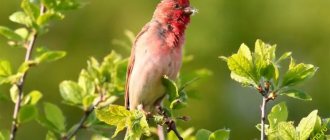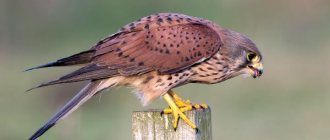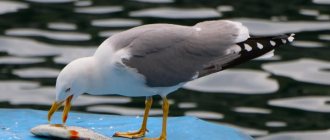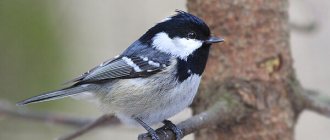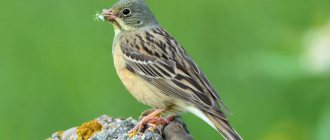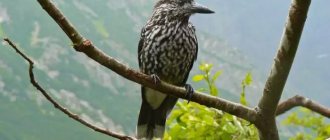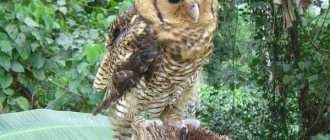Description of the bird
Small redpoll songbirds belong to the finch family, genus Goldfinches.
Their body length is on average 12-15 cm, wingspan from 20 to 25 cm. Weight can reach 20 g. The color of the plumage on the back of males is brownish-gray. The forehead and crown of the birds are decorated with bright red spots. The throat is white with dark spots. The breast is pinkish-white, the belly is pure white. The wings are brown with white edges. Young animals and females can boast of a red color only in the crown area. Legs are brown. The tail is long and dark.
— Advertising —
The lifespan of tap dancers is up to 8 years.
Lifestyle
male and female Inhabit shrub tundra overgrown with willow and birch trees; taiga with small swampy glades and lakeside and riverine laidas. They usually fly in dense flocks with continuous chirping. Voice - repeated “che-che”, “che-che-che”, “chen”, “cheeee”, “chiv”, “chuv”. They sing little, mainly in the spring. The song is a set of the same calls and a dry trill “trrrrrrrrr”. For the winter they migrate or fly away to the south, going beyond the breeding area to the southern regions of Europe and Asia. The basis of nutrition is the seeds of various tree and shrub plants, mainly birch and to a lesser extent spruce seeds, in August-September also seeds of sedges, cereals, lingonberries and crowberries; They also feed on insects, most often aphids. They live up to 8 years.
Feeding features of tap dancers
Tap dancers feed on mixed food.
The basis of their diet is, first of all, seeds of shrubs and trees (birch, spruce, aspen, alder), cereal plants, as well as berries (lingonberries, crowberries). Tap dancers readily eat weeds, which helps humans in agriculture.
— Advertising —
Birds can also eat insects, including pests such as aphids. Tap dancers feed their chicks with insects.
Natural enemies
Humans pose minimal threat to robins. They even managed to adapt to deforestation and reduction of nesting sites. But owls, falcons, weasels, martens and stoats willingly attack small, gullible birds and often destroy nests located too close to the ground.
Photo: pxhere.com
Finch (50 photos): description of the bird, habitat and what it eats
Distribution of tap dancing in nature
Tap dance species are widespread in the north of the Eurasian continent, as well as in North America and Greenland.
Birds nest in shrubby tundra overgrown with willow and birch trees, the seeds of which are eaten; less often - in the taiga, in places with small wet glades or along the banks of lakes and rivers.
Tap dancers are not afraid of people and can build nests near human habitation.
Habitats
The tap dance bird is found on continents such as Eurasia and North America. You can also see it in Greenland.
If we talk about Russia, the bird’s main habitat is the northern regions of the country. Although the bird belongs to the nomadic species, it prefers the tundra, forest-tundra, as well as those forest zones in which deciduous trees grow.
Taking into account seasonality, in summer tap dancing can be seen mainly in the taiga and forest-tundra zones. In winter, flocks of birds try to stay closer to the south, in the zone of mixed forests and forest-steppe. This way of life allows them to get more food during the difficult winter period.
Types of tap dancing
Common Redpoll
A small songbird, about the size of a siskin. The body length of the common tap dancer is from 12 to 15 cm, the wingspan is up to 25 cm, the weight is in the range of 10 – 15 g. The plumage on the back of the male is gray-brown or light gray. There are bright red spots on the crown and forehead, the throat is white with a dark spot, the breast is pinkish-red, and the belly is white. The rump is pink. The feathers on the wings are dark brown, decorated with white at the edges. Juveniles and females differ from males in that the red color is present only on the crown - in the form of a “cap”; throughout the rest of the plumage, red and pink shades are replaced by white.
The species is distributed in northern Eurasia and North America.
Mountain Redpoll or Yellownose
Externally, this species is very similar to linnets. The body length of the birds is 13-14 cm, weight from 15 to 20 g. Bright red spots are visible on the chest. The back is decorated with brown spots, the rump is black. The color of the abdomen varies from white to beige-yellow. The conical beak is gray in summer and yellow in winter.
The mountain redpoll is found in northern Europe and central Asia. Some populations are sedentary, but for the most part, birds fly to the shores of the southern seas for the winter.
Tundra or Tundra Redpoll, or Ashy Redpoll
The species resembles the common tap dancer in appearance, but differs from it in its lighter plumage. Body length - 13-15 cm, weight about 20 g. The plumage of the bird is gray on top with a light head and belly, decorated with stripes. The rump is white. The male has a pink color on the chest, while the female has a white chest. Representatives of both sexes wear a carmine-red “cap” on the crown of their head.
The bird lives in Greenland, in the countries of Northern Europe (Scandinavia, the Baltics, Iceland) and in northern Russia. The species is rarely found in Central Europe.
Offspring
The mating season for these birds is quite active. In flocks of tap dancers, real fuss begins, because the females must not only choose a worthy candidate for the role of the father of the family, but also have time to build a home.
Mating season is also a great opportunity to hear tap dancers sing. The bird, a photo of which can be seen below, flies in the air and tries to outshout other members of its flock. At the same time, she emits a loud whistle. Males especially try to stand out and show females that they are ready to reproduce and raise offspring. After a pair has formed, the birds begin to arrange their nests. Any natural material is suitable for this: thin twigs, moss, plant fluff. To keep the chicks warm, the inside of the “houses” is lined with feathers and down. Tap dancers prefer to build their nests low above the ground. Trees such as alder and birch are best suited for this purpose.
The female begins to lay eggs only after the home is completely ready. On average, she lays three to seven small bluish eggs. Their distinctive feature is the characteristic dark spots on the shell. The female incubates the clutch for about two weeks. During this time, she practically does not leave the nest even for feeding. All this time the father takes care of the female. He brings her food directly to the nest. Thus, nothing distracts the “mommy” from the incubation process.
The chicks are born very small and defenseless, but grow very quickly. For the first two weeks they are completely dependent on their parents. The father continues to bring food directly to the nest, but now for the offspring. In addition, his mother joins him. Tap dancer chicks decide to leave their home for the first time two weeks after birth. They learn to fly and begin to search for food on their own. The little chicks eat the same things as their parents: tree seeds and aphids.
After the first offspring can take care of itself, some couples begin to prepare for the next one. Thus, in one period, a pair of tap dancers can raise two generations of chicks.
Common Redpoll (Carduelis flammea). Slightly smaller than a sparrow (body weight of males 8.9-15.5 g, females 8.5-14.7 g). The color of the upper side of the body is grayish-brown with dark longitudinal streaks, there is a black spot under the beak, the forehead and crown are crimson, and there are dark longitudinal streaks on the sides of the body. The male's chest is crimson-red, while that of females and young ones is whitish with dark streaks.
Common tap dancers live not only in Europe, but also in North America. They can also be found in Greenland.
Birds nest in the bush tundra and taiga. They are so named for the sounds “che”, “chen”, “chiv” and “chuv” repeated in a simple song. For the winter, tap dancers from northern Europe fly to the south of the continent and Asia.
In Russia, the range extends east to Chukotka, the coast of the Bering Sea and to Kamchatka. Nests are usually built in bushes, low above the ground; There are from 3 to 7 eggs in the clutch; they are blue-white with dark spots.
Ashy tap dance
The Ashy Redpoll is also called the tundra or tundra redpoll and is similar to the common redpoll, but lighter in color. The rump is not striped, but white. The back is gray - hence the name of the species. Males have breasts with a faint pink tint; females do not have this color. The voice is like that of an ordinary tap dancer. The bird's home is the tundra. Outside Russia in Europe, it breeds in northern Scandinavia, in Norway. It is also found in Iceland and in North America - from the west coast of Alaska to the west coast of Hudson Bay. A separate subspecies lives in Greenland. In winter, the Ashy Redpoll can be seen in the Baltic countries. It is capable of producing hybrids with the common redpoll.
In Russia, the Ashy Redpoll is found throughout the north of the country: distributed from the Kola Peninsula to Chukotka. The nest is often located next to dwarf birch trees; There are usually 4-5 eggs in a clutch.
The tap dance bird belongs to the finch family.
When she sings, she makes a sound reminiscent of the clicking heels of a tap dancer, which is where she gets her name.
Male and female: main differences
Tap dancers have sexual dimorphism, the main manifestation of which is that males are richer and brighter in color. Both sexes have a red patch on the crown of the head. But males are distinguished by a pinkish-red breast and red spots on the body, while in females brown and white tones predominate in the plumage. Young birds resemble females in plumage color.
Keeping tap dancers at home
Tap dancers are not picky and quite simple to keep. But their simple song rarely attracts bird lovers.
In captivity, redpolls are kept in flocks, often in the same company as goldfinches or siskins. Watching the behavior of birds in such a common aviary is a pleasure.
Cage requirements
The cage for redpolls should be spacious with a large number of perches so that the bird can move enough and not gain excess weight.
Feeding tap dancers
Adult tap dancers prefer grain food; they feed only their chicks with insects.
The birds are fed with a regular canary grain mixture. But the food must be dietary. So, limit the consumption of hemp seeds, which can make tap dancers fat. Like all granivorous birds, redpolls need plenty of drinking water.
Robin breeding
Robins nest closer to the ground and hide in crevices of stumps and roots. They love abandoned holes and other secluded places, which they strengthen with moss, branches and leaves. Robins always carefully protect their nest from rain.
Nests are usually built by females while males defend the territory from competitors. Then the males take care of the small chicks at night, while the females hatch the second clutch. In general, robins have a very developed parental instinct.
One clutch contains 5-7 blue eggs, from which chicks appear within 2 weeks. At first they are very voracious, but then they grow quickly and after 2 weeks they try to leave the nest. The first year of life is the most difficult for robins, because they are not at all shy and are not very careful, which is why many chicks die.
Photo: smallivingworld.ru
Breeding tap dancers
Tap dancers breed in captivity. The female lays up to 7 small bluish eggs at a time, which she incubates for two weeks. Then both parents feed the offspring for the same amount of time.
In addition, tap dancers are often crossed with other species. For example, the common offspring of a female tap dancer and a canary will not only have a beautiful color with a pink breast and a red “cap,” but will also sing melodiously.
Malinovka – photo
Miniature robins with long, thin legs look simply adorable. Is not it?
Photo: pinterest.com
Photo: rasfokus.ru
Photo: elena-zhzhenova.livejournal.com
Photo: placepic.ru
Photo: placepic.ru
Photo: fotokto.ru
Photo: fotokto.ru
Photo: fotoload.ru
Photo: fotokto.ru
Photo: photocentra.ru
Photo: placepic.ru
Photo: wallbox.ru
Photo: pixabay.com
Photo: snt-apeks.ru
Photo: smallivingworld.ru
Photo: placepic.ru
Photo: infourok.ru
Photo: erbirds.ru
Photo: fotokto.ru
Photo: club.foto.ru
Photo: onedio.ru
Photo: wallhere.com
Did you like the post? Subscribe to our channel in Yandex.Zen, it really helps us in our development!
Interesting facts about the bird
- Tap dancers live in large, friendly flocks and constantly chirp while flying.
- The sound of the birds singing is reminiscent of the clicking of heels in a tap dance, which is where the species gets its name. And from Latin the species name of the birds is translated as “flaming thorn.”
- It is very interesting for tap dancers to get their food. They cling to tree branches like fluffy balls and can peck seeds and berries, hovering in a wide variety of positions.
- Tap dancers are very attentive and caring towards their offspring. Both the female and the male feed the chicks. And even after the young have left the nest, the parents continue to feed and train the offspring for some time.

